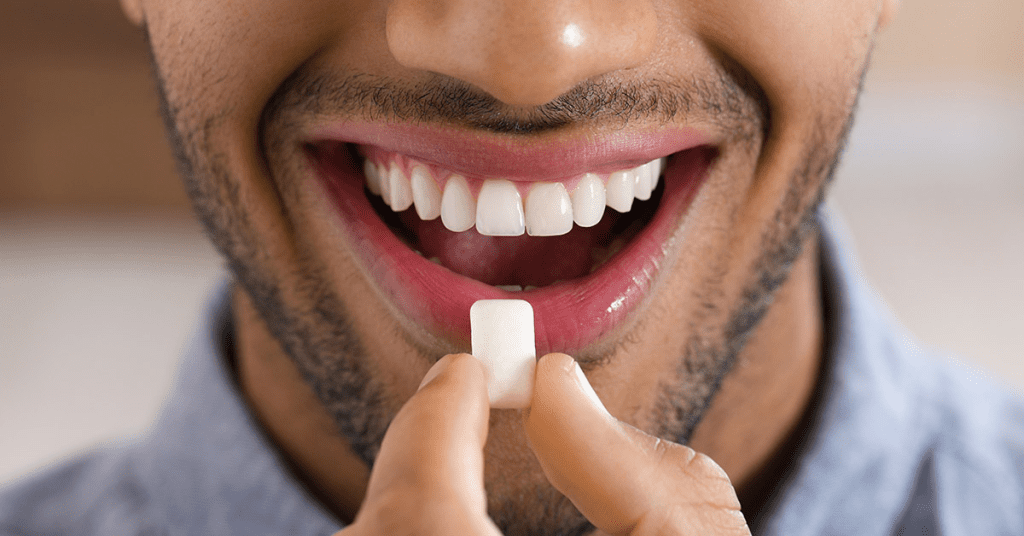Chewing gum has long been a staple for fresh breath and a quick distraction, but few people know the real ingredients behind that stick of gum. Despite its harmless appearance, the components of chewing gum might surprise even the most health-conscious consumers. From synthetic rubber to wax derived from sheep, let’s take a closer look at what goes into the gum you chew every day.
From Natural Sap to Synthetic Rubber

In its early days, chewing gum was made from the natural sap of the Sapodilla tree, known as chicle. This sap provided a naturally chewy base, giving gum its original, all-natural texture. However, as the demand for gum grew, manufacturers transitioned from chicle to synthetic materials. Today, most gums use polyisobutylene—a synthetic rubber often found in products like inner tubes—as a primary ingredient. This shift was made for durability, but for many, discovering that they’re chewing on rubber is an unexpected and unsettling realization.
Rubber in Your Mouth? The Truth Behind Polyisobutylene
Polyisobutylene, the rubbery component in modern gum, is mixed with food-grade plasticizers to give it that stretchy, chewable texture we’re familiar with. According to BBC Science Focus, polyisobutylene softens at body temperature, ensuring the gum retains its elasticity without breaking down. While this rubber-based compound is considered safe, the thought of chewing something akin to inner tube material isn’t exactly appetizing for everyone.
Lanolin: The Waxy Secretion from Sheep
One of the more surprising ingredients in some chewing gum brands is lanolin—a waxy substance derived from the oil glands of sheep’s wool. Lanolin is commonly used in skincare products for its moisturizing properties, but it’s also added to gum to create a smooth, glossy texture. The fact that lanolin is derived from sheep wool is not well-known and has left many consumers shocked. Since lanolin is included in the overall “gum base,” manufacturers aren’t required to list it separately as an ingredient.
Artificial Sweeteners: The Sweet but Controversial Choice
Today’s gums often rely on artificial sweeteners like aspartame instead of sugar. Aspartame is roughly 200 times sweeter than sugar, helping to cut calories while keeping the gum flavorful. However, aspartame’s use has sparked debates due to concerns about potential health risks associated with long-term use. According to the Mayo Clinic, artificial sweeteners are generally safe in moderate amounts, but some studies have linked excessive consumption of these sweeteners with an increased risk of stroke and heart disease. While conclusive evidence is still lacking, it’s enough to make some consumers wary.
The Role of Butylated Hydroxytoluene (BHT)
To preserve freshness, certain gum brands use butylated hydroxytoluene, or BHT. Known for its antioxidant properties, BHT helps prevent the gum’s ingredients from breaking down over time. While the FDA considers BHT safe in small amounts, studies have shown that high doses of BHT in animals can lead to cancer, making it a controversial ingredient. Although the levels of BHT in gum are quite low, its reputation has led some people to seek out gum brands that avoid using this additive altogether.
Health Risks of Excessive Chewing: TMJ and More

Beyond the ingredients themselves, excessive gum chewing can lead to its own set of health issues. Constant chewing can strain the temporomandibular joint (TMJ), the hinge connecting your jawbone to your skull. Over time, TMJ strain can lead to jaw pain, inflammation, headaches, and even earaches. This problem is particularly common in children and teenagers who chew gum excessively, making moderation a key factor for gum lovers.
Seeking Natural Alternatives: Chicle and Corn Zein
For those concerned about synthetic ingredients, some brands are now offering natural alternatives. Chicle, the original plant-based gum base, is still used by a few niche brands looking to provide a more natural option. Another emerging alternative is corn zein, a protein derived from corn that offers a similar chew without synthetic compounds. Though these options are less common and often pricier, they provide a more natural experience for those looking to avoid rubber and artificial additives.
The Truth About Swallowing Gum: Debunking the Myths

One of the most enduring myths about gum is that swallowing it leads to a sticky buildup in your stomach. In reality, while gum is resistant to digestion, it passes through the digestive system like any other indigestible substance. According to BBC Science Focus, swallowed gum “continues its merry way along your digestive tract” and exits the body naturally. So while the ingredients might raise a few eyebrows, swallowing a piece of gum occasionally won’t harm your stomach.
Making Informed Choices: Do You Really Know What You’re Chewing?
For many, learning about what’s really inside chewing gum has been an eye-opener. From rubber-like polyisobutylene to lanolin from sheep, the ingredients in chewing gum reveal the surprising choices made by manufacturers to enhance chewiness, flavor, and shelf life. Although the FDA deems these ingredients safe, some consumers prefer to seek out more natural alternatives. With new information at hand, it’s up to each individual to decide if they want to stick with traditional gum or opt for plant-based versions.
Conclusion: Choosing What’s Right for You

Chewing gum is one of those everyday products that often goes unquestioned, but as we’ve seen, there’s a lot more to it than meets the eye. The ingredients in most chewing gums are safe, yet the knowledge of what you’re really chewing on—whether rubber, lanolin, or artificial sweeteners—can be enough to make some people think twice. For those who are concerned, natural alternatives are available, though less common. Whether you choose to keep your usual brand or explore new, plant-based options, being aware of what’s in your gum empowers you to make choices that align with your health priorities and personal values.


